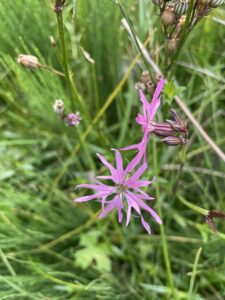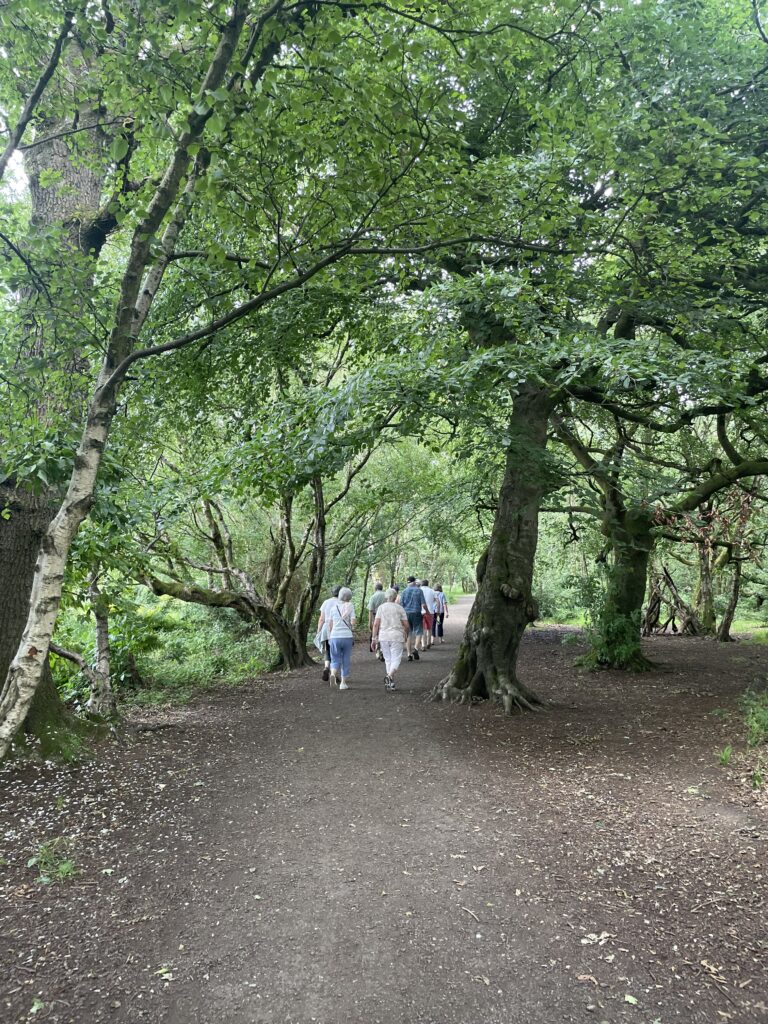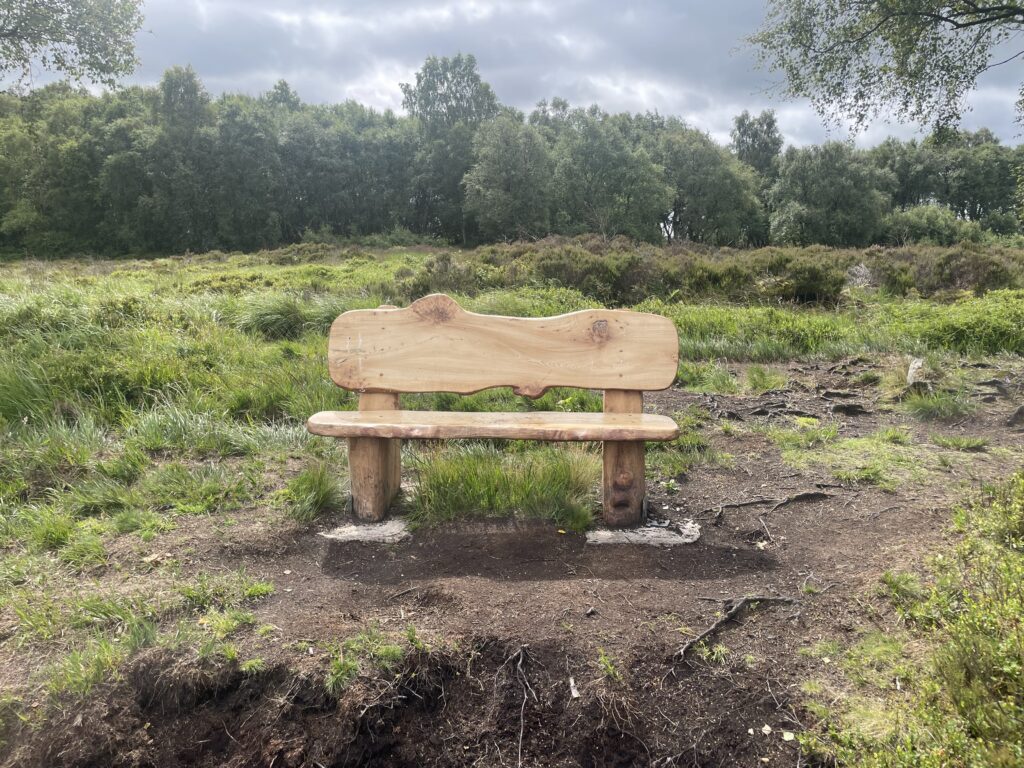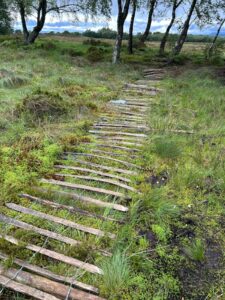
To wake in the quiet moments when the day inhales and the night fails. Just you and the stuff that surrounds you. To be extra alive in a way that near silence allows, sensitive to minute moments of change. To be able to gather yourself, your thoughts and feelings, whether it is to sit, to write, to walk, to read, to be inside or outside, to be sowing seed, to garden, to be saturated in experience. (Allan Jenkins, Morning)
Towards the end of a working day, I email Cathy to tell her about this project, and she replies enthusiastically. I send some possible dates, including the following day, and this works for her. And she has a suggestion. Cathy tells me that she is in the habit of walking round the Moss at 6am – a routine that started during lockdown but that she has kept up from time to time in the years that followed. She wonders if I would be up for joining her at such a ‘bonkers’ time in the morning. I am.
I wake minutes before my alarm and hurry out of the house to join Cathy on time. There is no traffic on Kirkintilloch Road. Not a single car. We meet outside Euphoria Salon by the station carpark, just as a train departs with a handful of reluctant commuters nursing their travel mugs. It feels good to be out at this time, but without the pressure of emails and morning meetings. That is the world in which we usually see each other. Cathy is my colleague at the University of Edinburgh – a Professor in Student Engagement in Higher Education. When I first moved to Lenzie, I was pleased to discover that she lives here too, and we once met in Billington’s to chat about work projects. This time the conversation will steer clear of academic business, and I will ask her about her connection with the Moss.
Like me, Cathy always walks anticlockwise, so we set off up Bea’s Path. Cathy says she is a ‘perimeter girl’ and we agree to stick to the main route on this occasion. The Moss is quiet and I am struck by the absence of traffic noise, which I hadn’t even noticed before it was gone. The air is fragrant with pollen and it is warm for this time of day. We peer through the trees as Cathy says this is a great time to see the deer, but they don’t reveal themselves, for now. I photograph meadow geraniums and miss a thrush flying close by. A few people pass us, some walking some running, one sprinting at an impressive rate. All of them share a warm good morning greeting that is quite different to the type of nodded acknowledgement that is more typical on these walks. There is a sense of solidarity with the other early risers.
Cathy tells me that she is a huge advocate for peatlands and knows how much they do for the environment. She is sure that this site needs to be protected and worries about dogs being allowed to run off their leads through the bog. But she is also considerate of the different ways in which people use the site. Cathy tells me that in the early days of the lockdown, ‘road closed’ signs appeared at either end of boardwalk, which was in a state of disrepair at the time. Very soon, the signs had been removed, and the walkway had been patched up – perhaps by a local carpenter. People will always find ways to do what they want to do here.
As we turn onto the boardwalk, a dog walker stops to chat. He has noticed me making notes on the folded sheet of A4 that I always bring with me on these walks. This simple incongruity in the way that people behave here has signalled to him that there is something going on, and he asks what I’m writing. I tell him about the project, and he shares his experience. He has lived in Lenzie his whole life, remembers peat cutting as late as the 80s (long after the commercial operation had ended). And he is very strongly opposed to the way that the council manage the site. His main concern is the ‘weed wiping’, a method of targeted herbicide application that I have heard about before. I have been told that this is to control the encroachment of the birch wood into the peat bog. He worries that it affects the deer. I give him my email address and ask him to get in touch, and we shake hands. I hope I will get to walk with him one day and will look out for him on future visits. The fastest of the joggers passes us again.
Cathy and I take a moment to sit on one of the benches that line the boardwalk, and we are immediately rewarded by a pair of energetic roe deer bouncing through the heather. We hear one of them before we see them. A deep raspy breath breaking through the silence of the morning. Then we watch them playing on the raised mound, chasing each other and jumping into the air with abandon. I have seen these deer numerous times on the Moss, but I have never seen them move like this. This is their time – before the people arrive with more dogs. Meadow pipits join the dance: rising and falling in the stillness.
The Moss is truly beautiful in this light. We look out to the Campsies, which have a thin cloud layer balancing on their peaks. We take photographs and try to do justice to the gentle glow of sunrise, framing the church spire and the trees around the part of the town where I live. Cathy loves this time of year, when it is possible to be out so early. In winter, it feels more remote, and the darkness is not so welcoming. I am looking forward to walking with others in different seasons and at different times. This morning’s walk has shown me that the Moss has a different character in the first hours of daylight, so I wonder what it will be like in the nighttime. We walk on to the pathway bordering the trainline and the jogger passes us for the third time.
As we emerge into the carpark again, the atmosphere is entirely different. People are filling the parking spaces or locking up their bikes at the station. There are conversations, drop offs, arrivals and departures. Everyone is more awake. We say our goodbyes and I thank Cathy for a very enjoyable start to the day. As I walk back up the main road, there are tens of vehicles moving in both directions. The estate agents and cafe are setting up and a bin lorry turns into the residential areas. The day has begun.



